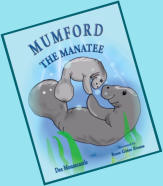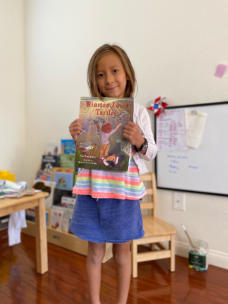


© 2018-2023 Deirdre D. Mountcastle, P.A.
All rights reserved
Design by RHavekost

Mumford
the Manatee
presents
MountcastleBooks


Short Introduction to Sea Turtles
Flatback turtle: nests in a northern Australia, Indonesia and southern Papua New Guinea. When the eggs hatch the babies are bigger than other species so they have a better chance of survival. o The class might enjoy looking up these places where the flatback resides and drawing pictures of the sea turtles both the hatchlings and the adults. Green Turtles: these turtles main diet consists mostly eat sea plants. Unfortunately, these young turtles often suffer from tumors. No one knows why they suffer from these but the University of Florida has a hospital where these turtles are operated on and, after recovery, are returned to the ocean. Usually they are tagged so if they return with more tumors the university can study them. o Your students can draw pictures of the green turtle in their habitat eating sea plants. The Monterey Bay Aquarium has PDFs of sea creatures, including the green turtle. Hawksbill turtles: the most important thing about these turtles is they are an endangered species. They are found in both Atlantic and Indo-pacific. Because they are an endangered species it is important to let the public become aware of this. No matter where you live the class should send a picture of the turtle and write some information about the turtle and send it to the local papers. This way the word gets out that we must protect these turtles. Leatherback turtle: these turtles are extremely large. They, too, are endangered; they love to lay eggs on sandy beaches. They love to eat jellyfish. The problem with that is they cannot tell the difference between jellyfish and plastic bags. o A good activity for the class might be to again get the word out to not litter beaches with plastic bags and when boating keep your trash safely on the boat and deposit it on land in a trash bin. The class might enjoy making a shoebox design of a leatherback turtle in his habitat. Olive Ridley turtle: these turtles do best in temperate waters. They nest along Brazil, Suriname, French Guiana and in the southern Atlantic Ocean. o The class might enjoy exploring these countries as part of a history lesson. They can learn about cultures, government and how their waters are protected. Kemp’s Ridley turtle: these turtles are the smallest and have a triangular shaped head. They like eating mollusks, crabs and jellyfish, and algae. They, too, are endangered. They nest every three years and they like sandy and muddy bottoms. o The class might enjoy making a 3-D version of this turtle in his habitat using clay or papier mâché. Perhaps children could make real sandy or muddy sea bottoms by inserting all kinds of used plastic to make the turtle diorama then painting it and placing it in the 3-D cardboard picture. Loggerhead turtle: these turtles can be found in the Atlantic Ocean. Around the age of 35, the female reaches maturity to start laying eggs. They can lay hundreds of eggs along the beach dune usually at night between May to September. o A good classroom project would be to set up a real egg nest. You can make the big loggerhead tracks going up a beach or you might want to make a nest with the baby hatchling emerging and heading for the ocean. o A natural follow-up would be to build your own hatchling. The North Carolina Aquarium at Fort Fisher has a neat PDF using rocks and paint as raw materials.Other Activities
Have students (in groups or as a class) brainstorm and create a concept map of what they would require as individuals to survive and compare it to the same needs for a sea turtle. Oregon State University Hatfield Marine Science Center has a PDF which, while it doesn’t include sea turtles, is excellent. The class can adopt a loggerhead turtle hatchling, with the assistance of the North Carolina Aquarium, you will receive weekly updates (current weight and length), chart the hatchling’s growth over the school year, and receive a certificate of participation. Classroom Catch-Phrases for classroom signs Do Not Catch or Harass Sea Turtles. If you see a turtle on the beach or struggling in the surf, please call the Florida Fish and Wildlife Conservation Commission at 1- 888-404-3922. [change to your state’s appropriate agency if not in Florida]Helpful Links for Parents and Educators
If you are visiting St. Augustine, you might want to visit the Whitney Hospital by Marineland mentioned in the story. If your school is not in the local area, perhaps one of the other sea turtle rehabilitation facility and research locations listed below might be nearby. If physically visiting a facility is not feasible, the North Carolina Aquarium at Fort Fisher offers private virtual gatherings featuring a live Animal Ambassador from the Aquarium and a guest animal (naturally, I favor a sea turtle) with plenty of opportunity to ask questions. There is a fee for these fifteen-minute programs. Most of the following also have You Tube presentations as well as special resources for teachers. You may need to extract the video from the You Tube screen, to avoid exposing your viewers to web ads. Another great resource is the National Oceanographic and Atmospheric Agency’s (NOAA) Outreach and Education website.Sea Turtle Rehabilitation Facilities
East and Gulf Coasts of the United States o Florida Gumbo Limbo Nature Center, Boca Raton Loggerhead MarineLife Center, Juno Marine Science Center, Ponce Inlet (Daytona Beach) NOAA Southeast Fisheries Science Center, Panama City Sea Turtle Healing Center at Brevard Zoo (Not Open to The Public) Sea Turtle Rehabilitation Hospital, Mote Marine Laboratory, Sarasota5 The Florida Aquarium. Tampa The Sea Turtle Hospital at Whitney Laboratory, St. Augustine The Turtle Hospital, Marathon o Georgia Georgia Sea Turtle Center on Jekyll Island o Louisiana Coastal Wildlife Network New Orleans NOAA Estuarine Habitats and Coastal Fisheries Center, Lafayette o Mississippi Institute for Marine Mammal Studies, Gulfport NOAA Southeast Fisheries Science Center, Pascagoula NOAA Southeast Fisheries Science Center, Stennis o North Carolina Karen Beasley Sea Turtle Rescue and Rehabilitation in Surf City NOAA Southeast Fisheries Science Center, Beaufort North Carolina Aquarium at Fort Fisher, Kure Beach o South Carolina Sea Turtle Care Center at the South Carolina Aquarium in Charleston o Texas NOAA Southeast Fisheries Science Center, Galveston Sea Turtle, Inc., South Padre Island Bermuda and the Caribbean Sea o Association of Reef Keepers, Turtle Encounters Project, British Virgin Islands o Old Hegg Turtle Sanctuary, Bequia, St. Vincent and the Grenadines o Turks and Caicos Islands Turtle Project o Wildlife Rehabilitation Program at Bermuda Aquarium Museum and Zoo Pacific Coast of the United States o California Monterey Bay Aquarium, Monterey Birch Aquarium, Scripps Institution of Oceanography, UC San Diego o Hawaii Maui Ocean Center NOAA Pacific Islands Fisheries Science Center, Honolulu o Oregon Newport Research Station, NOAA Northwest Fisheries Science Center, Newport Point Adams Research Station, NOAA Northwest Fisheries Science Center, Hammond o Washington Pasco Research Station, NOAA Northwest Fisheries Science Center, PascoOther agencies participating in sea turtle rescue and rehabilitation
Turtles Fly Too! (Miami, FL and Boise, ID) interesting report in their April-May 2020 newsletter about emergency rescue mission for one loggerhead and sixteen cold-stunned Kemp’s Ridley sea turtles flown from the New England Aquarium in Quincy, MA to the Georgia Sea Turtle Center on Jekyll Island, GA. NOAA Fisheries Other links of interest NOAA Marine Turtle Ecology & Assessment Research Marine Turtle Tagging Marine Turtle Genetics Green Turtle Wallpaper for your computer desktop, courtesy of the Monterey Bay AquariumOther Video Links
Plastic found in the smallest of baby sea turtles in Northeast Florida Turtle rehabilitated and released by the Turtle Hospital Go Slow, Sea Turtles Below The Marvelous Musical Report on the Marine National Monuments Turtle Takes a Sun Bath



































































